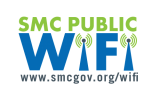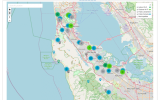
Redwood City – Need to find the nearest WiFi portal for school or work?
The County of San Mateo now provides an online hub showing a user’s nearest free and safe public WiFi access points.
Go to www.smcgov.org/wifi to find libraries, schools, County-sponsored access points and other locations with free and safe WiFi. The innovative service directs users to the nearest access point via Google maps.
The service – unveiled at today’s meeting of the San Mateo County Board of Supervisors – is the latest innovation to help students plug in to distance learning during the pandemic. It also helps the economy by allowing anyone with a smart device to connect with work or to find out about public services and job opportunities.

“Creating digital equity and ensuring access to the internet is critical to our quality of life for everyone in the community — especially during the pandemic,” said County Chief Information Officer Jon Walton.
The service is part of the County’s Digital Equity Portal, the latest example of the County’s commitment to overcome the digital divide. Since 2014 the County has invested millions of dollars to install free and safe public WiFi access points from Daly City to East Palo Alto and Coyote Point to Pescadero.
The SMC Digital Equity Portal is available at www.smcgov.org/wifi.
“From our coast to our more urban areas, we have leveraged data, mapping, and innovative technology to connect thousands of San Mateo County students, families, and small businesses to the internet,” Walton said.
With the pandemic spurring added urgency, the County has added more than 230 SMC Public WiFi access points and extended the public WiFi network at 12 public sites over a six-month period in 2020.

The development of the SMC Digital Equity Portal is part of the County’s Digital Inclusion Initiative that the Board of Supervisors funded with $6.3 million in Coronavirus Aid, Relief and Economic Security Act (CARES) funding.
The goal is to address the digital divide and challenges COVID-19 created for K-12 students, teachers, and families who had to quickly shift to distance learning.
“The digital divide must be eliminated if we want all of our students to succeed academically at the same levels, no matter your ZIP code,” said David J. Canepa, president of the Board of Supervisors.
“We can’t let any students fall behind because of distance learning and must provide them and their families with the tools necessary to attain a quality education. Our ISD team has done a remarkable job of bringing free public WiFi to the communities most in need, not just for our children but for adults too.”
The County in 2014 set out to connect the community with free and safe public WiFi based on four goals:
► Connect underserved communities
► Support educational opportunities for students
► Spur economic development
► Provide greater access to County services.
“The Digital Equity Portal is a great tool as we expand free, outdoor wireless access at all San Mateo County libraries,” said San Mateo County Libraries Director Anne-Marie Despain.
“We are delighted to be partners with the County of San Mateo and offer free WiFi access to anyone in our communities that need it. Libraries are learning spaces that strive to provide the public with free and equitable access to information. Wireless service that can be accessed outside of our buildings is another way we provide equitable access to information.”
Kaizen Technology Partners developed the portal, which is available at www.smcgov.org/wifi
“As an immigrant and single mom of four, internet access is a critical resource and needs to be treated as a utility,” said Dao Jensen, chief executive officer of Kaizen. The SMC Digital Equity Portal is a definitive step forward in the long path toward digital inclusion, said Kaizen Technolgoy Partners CEO Dao Jensen.
